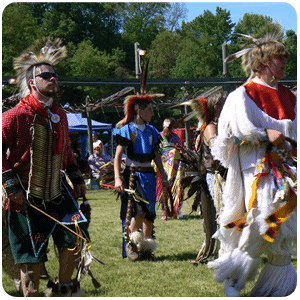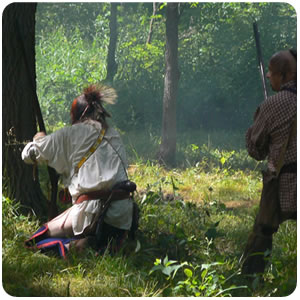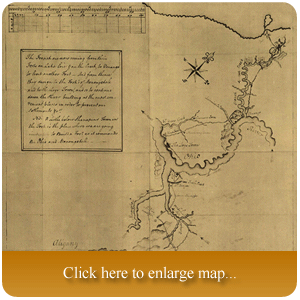Native Americans 
Native Americans inhabited the French Creek Valley from Archaic to Late Woodland times, an era spanning the period from 1,000 years before the birth of Christ to 1,000 years after. Archaeologists have excavated prehistoric village sites and burial mounds at Wilson Chutes, south of Meadville, PA, and at the McFate Farm in Cochranton, PA, the region’s most extensively investigated location.
Native settlement and subsistence in the watershed were largely determined by environmental factors that included pigeon roosts, deer licks, waterfowl migrations, nut groves, soil character and river riffles. Hunting, fishing, and foraging were principal occupations. However, fire management was also a critical survival tool. Natives burned woodlands to create large meadows and prairies that supported the growth of natural grasses and plants suitable for food and fiber and to attract and sustain wildlife, particularly deer. These areas were a prominent part of the landscape upon the arrival of Europeans. Noteworthy examples occur on French Creek near the confluence of Cussewago and LeBoeuf Creeks, and several mid-eighteenth century accounts report their existence from the mouth French Creek to Lake LeBoeuf. Washington’s 1753 journal noted “several extensive and very rich meadows, one of which, I believe was nearly four miles in length and considerably wide in some places.” A 1760 record kept by Colonel Henry Bouquet, a prominent British officer during the French and Indian War, includes a description of a prairie south of Meadville as “the richest Meadows I ever saw, quite clear more than Two Miles in length & half a Mile Broad.”
Tribal affiliations of natives in the watershed were primarily Seneca, members of the Iroquois Confederacy, and the Lenape, or Delaware Tribe, an Algonquian people who were displaced from eastern Pennsylvania in the 18th century by progressive European encroachment. The largest native settlement in the French Creek Valley was a Delaware village, Custaloga’s Town, located at the confluence of French Creek and North Deer Creek in Mercer County, PA. Another was located at the mouth of the Cussewago River. John Reynolds, one of the earliest European settlers in the region, described the native activities he observed:
“The fall and winter of 1798-99 we had in close proximity several Indian camps, they supplied us with meat; in that day they overspread this region. It was their favorite hunting land on every little stream they made their encampment, and hunted and trapped through autumn and winter; in the spring they returned their towns and through the summer scattered along the river fishing and watching deer licks, while the squaws raised a little corn and some vegetables, dressing deerskins and made moccasins…”
During the seventeenth century many of the people in the watershed were dispersed by intertribal warfare and the region was only sparsely populated. With the arrival of Europeans, native tribes formed political and military alignments with the French or various English colonies, and were inevitably drawn into the conflict that culminated in the French and Indian, or Seven Years War, waged from 1754 to 1763.
 Early Settlement
Early Settlement
Iroquois claims to lands in northwestern Pennsylvania encompassing the watershed were not ceded until the second treaty of Fort Stanwix in 1784, delaying permanent settlement in the region until after that time. In 1788, the first European settlement in the French Creek Watershed was established at Meadville, site of the former Delaware town of Cussewago. Erie and Franklin, PA were surveyed in 1795 and settled thereafter. Many of the early settlers in the watershed were veterans of the Revolutionary War who received land patents in exchange for their service.
In 1800, there were approximately 2,500 settlers in Crawford County. Ten years later there were 6,000, and by 1830 there were 16,000. Most were engaged in farming and the lumber industry, occupations attributable to rich soils in the watershed. From the 1840s to the turn of the century the region was profoundly affected by the Industrial Revolution and related events occurring during that era, including the opening of the Erie Extension Canal in 1844, founding of the Pennsylvania Railroad in 1846, and the discovery of oil near the watershed in 1859.
Today approximately 40 percent of the land in the watershed is farmed and slightly more than half is forested. The rural character of the watershed has helped to minimize pollution and is a significant factor contributing to French Creek’s remarkable biodiversity.
A Focal Point in Early American History 
George Washington’s Visit
When Lieutenant Governor Robert Dinwiddie learned that the French had built Fort Presque Isle and Fort Le Beouf, he believed the French were threatening Virginia’s interests in the Ohio Valley. He sent an eight-man expedition to deliver a message demanding that the French leave the region and halt their harassment of English traders.
A 21 year old surveyor and Major in the Virginia Regiment named George Washington, volunteered to be Dinwiddie’s emissary. George was eager to gain a commission in the British Army, and hoped this would help his chances. Dinwiddie commissioned and appointed George to lead the mission. On October 31, 1753 the party of eight left Williamsburg, Virginia by horseback. Washington was accompanied by Jacob Van Braam, a family friend who spoke French, Christopher Gist, an Ohio company trader and seasoned guide. and John Davidson, an interpreter fluent in several Indian dialects. They traveled up the Allegheny to its confluence with French Creek at Venango, where Washington was told that he must speak to officers located further upstream at Fort LeBoeuf.
Reaching Fort LeBoeuf on December 11, 1753, Washington conferred with French commander Captain Jacques Legardeur de Saint-Pierre. He was treated with deference, but received no favorable reply to Dinwiddie’s request for French removal. Legardeur suggested that Washington was wasting his time by trying international diplomacy with him. He suggested that Quebec, was the place to submit such messages. Legardeur’s position was firm but courteous: “As to the summons you send me to retire, I do not think myself obliged to obey it.”
The horses were spent and tired—the long hard journey had taken its toll. Washington sent the horses on ahead with his hired hands and the rest of the party traveled by canoe down French Creek. On the perilous return trip, Washington and his guide Christopher Gist survived capsizing in the icy waters of both French Creek and the Allegheny River. Washington’s journal of the adventure underscores the hazards of winter travel along French Creek, and is rife with references of landmarks throughout the watershed.
When Washington arrived back in Williamsburg on January 16, 1754, Governor Dinwiddie immediately asked him to prepare a written report for the House of Burgesses. Dinwiddie then had this report printed, and it became very popular reading. “The Journal of Major George Washington” was reprinted in various colonial newspapers as far away as Boston, and a British edition was issued in London later that same year, for which Washington also sent materials for the preparation of a map in which he applied the term “French Creek” for the Riviere aux Boeuf. Since then—everyone referred to the river as “The French Creek”
Just six months after his journey Washington led a party that ambushed French troops in a skirmish known as the Battle of Jumonville Glen, the first “official” engagement of the French and Indian War that eventually ended French claims to the Ohio Territory.
American settlement of the French Creek Watershed began after the cessation of land by Native Americans at the Second Treaty of Fort Stanwix in 1784. In 1800, there were approximately 2,500 settlers in Crawford County. Ten years later there were approximately 6,000, and by 1830 there were 16,000. The fertile soil of the French Creek Valley made it among the most prized farmland in northwestern Pennsylvania.
 A Military Highway
A Military Highway
The French Creek Watershed was included in the vast Ohio Territory claimed by both France and England, and ongoing conflict among these empires in North America in the 17th and 18th centuries had a profound regional impact on native culture and European settlement. In 1749, in an attempt to reinforce its claims in the Ohio Valley and stem British involvement in the native fur trade, the governor of New France commissioned Captain Pierre Joseph de Celoron de Blainville to assert French claims to sovereignty in the Ohio Valley. The expedition planted lead plates with the French claims to sovereignty at intervals along its route. One of the plates was placed at the confluence of Riviere aux Boeufs and La Belle Riviere, French names for French Creek and the Allegheny River, at present day Franklin. A small native village of about ten cabins was located at the site at that time.
It was clear that whoever controlled the headwaters of the Ohio, including the Allegheny and French Creek drainages, would be positioned to control the entire route to the Mississippi River. In 1753 and 1754, the French erected a line of forts along the waterway: Fort Presque Isle in Erie, Fort de la Riviere au Boeuf in Waterford, Fort Machault in Franklin, and Fort Duquesne in Pittsburgh. This military build-up drew the attention of Virginia, whose Ohio Company had land interests in the Ohio Valley, as well as Pennsylvania traders and land speculators operating in the region. It was also a source for consternation among the Delaware, Shawnee and Mingo tribes who lived in the French Creek-Allegheny-Ohio watershed. In the midst of these tensions, George Washington appeared carrying an ultimatum to the French.
Colonial Stream
French Creek is often referred to as a “Colonial Stream” due to the fact that its exceptional biodiversity and water quality have remained largely unchanged since the Colonial era. But the term also refers to the rich history associated with the French Creek Watershed. From its unique glacial past to the journey of a young George Washington on its waters in 1753, French Creek’s historical waters are truly deep and fascinating.


